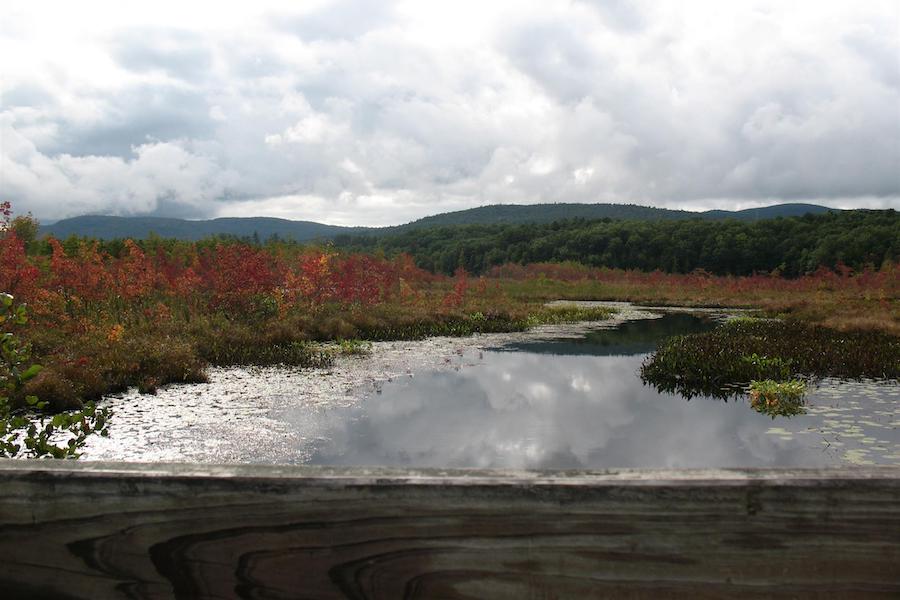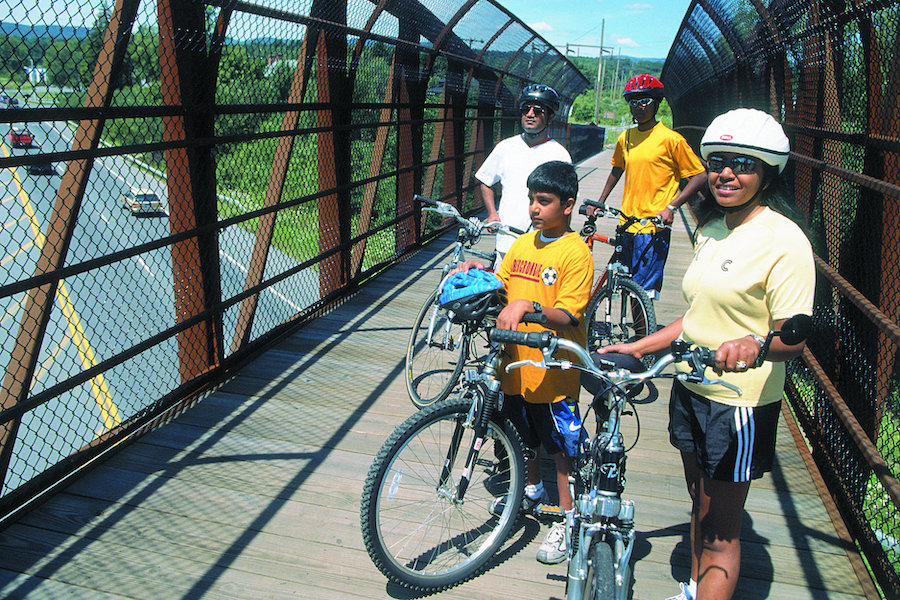New York’s Warren County Bikeway

Trail of the Month: April 2019
“A scenic and safe riding route with endless opportunities to explore nearby communities and local points of interest along the way”
—Joanne Conley, tourism director for Warren County
More than three million visitors flock to New York’s Lake George every year, searching for fun or diving into history on its namesake lake and the southern Adirondack Mountains. Plenty of them are finding both on one of the nation’s early rail-trails.
The Warren County Bikeway runs 10 miles between Glens Falls and Lake George, about an hour’s drive north of Albany. Riders pedal over rolling hills, past historic sites and picturesque villages, and through lush forests filled with pine and cedar trees. The trail is paved, but there’s a 1.5-mile section that takes riders off the path and along lightly traveled suburban streets and the Glens Falls Country Club.
“The beauty of the Bikeway is that it offers opportunities to cyclists of all ability levels, from families with younger children to recreational riders to athletes-in-training,” said Joanne Conley, tourism director for Warren County. “It connects the City of Glens Falls to the Village of Lake George by providing a scenic and safe riding route with endless opportunities to explore nearby communities and local points of interest along the way.”
Past (History Runs Deep)

History through the region runs as deep as Lake George. The Warren County Bikeway was built on an old Delaware & Hudson Railroad line that shuttled visitors primarily from New York City and Albany to the tourist town of Caldwell (now called, appropriately enough, Lake George). Many visitors would then hop aboard one of the steamboats, which would take them on a picturesque cruise or even drop them off at their lakeside cottage.
“The last train would leave (Lake George) at midnight, allowing businessmen to be back in New York City by mid-morning on Monday for work,” said Margy Mannix, a historian for Lake George.
The decline of the railroad coincided with the rise of automobiles after WWII. By the time the last train departed in the mid-1950s, they were only carrying as few as a couple of passengers per trip. The railroad abandoned the line and sold much of the track for scrap. A local lumberyard managed the area for about a decade, Mannix said. The first section of the bikepath was built in 1978, placing it among the oldest rail-trails in the country.

The corridor has always been—and remains—an important transportation route, according to Kip Grant, a local amateur railroad historian.
“The Bikeway probably started out as a deer path, and over time became the most convenient route for travel between [a fort in] Glens Falls and Lake George, where another fort was located,” Grant said. “In subsequent eras, portions of the Bikeway hosted stage coaches on a corduroy road, early motorized vehicles on the first iteration of present-day Route 9, the electric Hudson Valley Railway and the Delaware & Hudson’s Lake George Branch.”
James Fenimore Cooper visited Lake George while writing the Last of the Mohicans in 1826, drawing inspiration from Fort William Henry as well as other spots along the future trail. And while nine feature films have been made based on the book, only one, a 1911 silent feature, was actually filmed in the Lake George area.
It’s easy to learn about history along the trail, thanks to nearly two dozen informational signs erected nearly 20 years ago. Utilizing the expertise of local amateur historians, Eagle Scout Ryan Wild created the anodized aluminum signs, each with a photo or graphics, revealing the region’s ties to the French and Indian War and the railroad.
Present

Unofficial estimates suggest that 100,000 walkers, runners, cyclists and rollerbladers use the trail each year. While most people are pedaling for fun, it’s not unusual to see employees of the local Six Flags Great Escape riding to work in their uniforms. The trail abuts the Lake George RV Park, and company president Dave King said about two-thirds of his 15,000 annual visitors use the trail at some point. Folks who didn’t bring bikes along quickly recognize their mistake, he added.
“Once they realize how many wonderful trails we have both in the resort and nearby, they want to know where they can rent bikes,” King said. “I’d estimate that they represent about 20 percent of our total guests. Even if they don’t normally bike on vacation, they’re more inclined to do so here because of the high-quality paved trails that take them to nearby attractions while being safely away from automotive traffic (in most cases).”

According to King, bicycling is becoming a component of the local economy—with visitors who rank outdoor recreation activities and biking as a top amenity spending an estimated $5 million+ annually in the area.
Because 10 miles can be just a warm-up ride for some, many visitors like connecting to nearby trails, said Tim Benway, director of Warren County Parks, Recreation and Railroad. The closest connector is the 9-mile Glens Falls Feeder Canal Towpath that passes through Glens Falls and is accessible by a short ride on the road. But there may be more options in the near future.
Future

Officials have proposed an extension that would take Warren County Bikeway travelers an additional 7 miles north to Warrensburg. If things come together quickly, the trail might be built within a year, according to GlensFalls.com, but it could also take as long as five years.
“Connecting to Warrensburg opens up more restaurants, shopping and recreational opportunities—as well as just a longer ride,” said Eric Pfau, communications specialist for the Warren County Tourism Department. “Beyond Warrensburg, the Bikeway could potentially connect with North Creek and Chestertown, two more vibrant Adirondack towns with a ton to offer.”

That extension could be part of the state’s proposed Empire State Trail plan to create a fully connected, 750-mile intra-state trail network. Some local officials are skeptical about the project—which would add an estimated 350 more miles of trails throughout the state—saying that money should be spent on highway infrastructure. But state officials estimate a fully connected trail could bring more than 8.5 million visitors (and their tourist dollars) to New York, as well as greatly benefit the health of local users.
And currently, there’s no stopping the Warren County Bikeway’s momentum, as both the government and local businesses are working to make the county an even more bicycling-friendly destination through branding and infrastructure additions.
“Since the Warren County Bikeway was conceived … the Bikeway has been a ground-breaking recreational asset that has charted a course for cycling in the Lake George Area,” said Conley.
Related: Trails Transform America: Empire State Trail
Related Links
Warren County Parks, Recreation & Railroad
Warren County Safe & Quality Biking Organization
Trail Facts
Name: Warren County Bikeway
Used railroad corridor: The bulk of the trail follows the Delaware & Hudson Railroad line between Lake George and Glens Falls, which was built in 1882 and inactive by 1956.
Trail website: Warren County Parks, Recreation, and Railroad
Length: 10 miles
County: Warren
Start point/end point: Platt Street between Katherine Street and NY 32/Warren Street (Glens Falls) to W. Brook Road and Beach Road (Lake George); most riders prefer to start from the south in Glens Falls, as the ascent is much more gradual.
Surface type: Asphalt
Grade: The trail begins gradually climbing around mile 2 with the sections between miles 2 and 3 and miles 5 and 6 being the steepest. The descent begins at mile 7 and continues straight down until you reach Lake George. The elevation grades are fairly reasonable throughout.
Uses: Walking, bicycling and inline skating; wheelchair accessible. Dogs and other animals are not permitted. Snowmobiles are currently allowed on the Bikeway from December through March between Bloody Pond and Fort George Roads.
Difficulty: Most of the Bikeway can easily be tackled by the most casual trail user, although they may have slight difficulty when the terrain becomes rolling hills.
Getting there: Albany International Airport (Albany Shaker Road, Colonie) is the closest major airport, served by most major airlines, including Southwest, Delta and JetBlue. The airport lies about an hour south of the Bikeway’s southern endpoint.
Access and parking: The Bikeway’s southern endpoint at Platt Street in Glens Falls doesn’t have designated trail parking; the closest trailhead with parking is Leonard Street, a short distance away. At the north end of the trail, parking is available in Lake George Beach State Park (138 Beach Road, Lake George).
To navigate the area with an interactive GIS map, and to see more photos, user reviews and ratings, plus loads of other trip-planning information, visit TrailLink.com, RTC’s free trail-finder website.
Rentals: Lake George Bike Rental (211 Canada St., Lake George; phone: 518.307.8673) is located a half-mile from the northern end of the trail; rates: $10 per hour, $25 for three hours and a daily rate of $40.

Donate
Everyone deserves access to safe ways to walk, bike, and be active outdoors.
